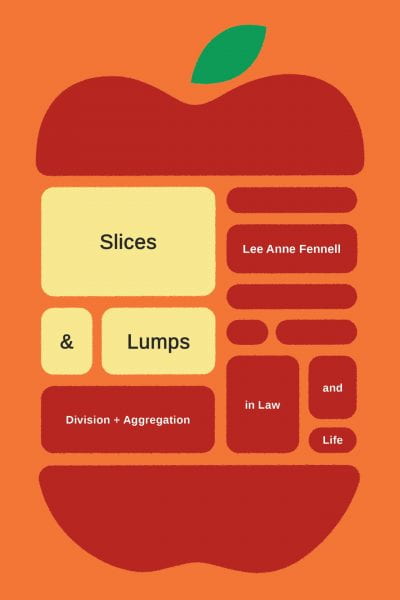Slices and Lumps: Division and Aggregation in Law and Life
(University of Chicago Press, 2019)
EXCERPTS / REVIEWS / RELATED WORK / AUDIO + VIDEO
 From “lumpy goods” like bridges and highways that are valuable only when complete, to resources and assets that become more useful when artfully subdivided, human well-being depends on assembling useful lumps and carving out useful slices.
From “lumpy goods” like bridges and highways that are valuable only when complete, to resources and assets that become more useful when artfully subdivided, human well-being depends on assembling useful lumps and carving out useful slices.
Challenges of aggregation and division surface in myriad contexts, from hot-button issues like eminent domain and the sharing economy to a wide range of collective action and personal decision settings. As increasing urbanization and environmental threats raise the stakes for assembling resources and cooperation, emerging forms of unbundling, from jobs to cars to homes to entertainment, have refined the slices in which we produce and consume. Yet the significance of configuration is often overlooked, leading to missed opportunities for improving our lives.
The future of the city, the workplace, the marketplace, and the environment all turn on matters of configuration, as do the prospects for more effective legal doctrines, for better management of finances and health, and more. This book reveals configuration’s power and potential—as a unifying concept and as a focus of public and private innovation.
Contents
Introduction
One / Surveying Lumpiness
Two / Assembly and Division
Three / Lumpy Goals, Segmented Resources
Four / Increments and Incentives
Five / Intrapersonal Dilemmas
Six / Saving and Spending
Seven / Work, Play, Risk
Eight / Buy, Own, Split
Nine / At Home
Ten / In the City
Eleven / Law’s Cliffs
Twelve / Legal Bundles
Conclusion
Acknowledgments
Notes
Bibliography
Index
Libraries / U Chicago Press / Amazon / Seminary Co-op
Reviews
“All in all, a very intriguing book.”
— Diane Coyle, Configuring the Lumpy Economy, The Enlightened Economist, November 11, 2019
“This is a wonderfully inventive and imaginative book. Things are ‘lumpy’ when indivisible. Things are ‘slicey’ when they would be more useful if divided up than they would be if whole. For example, slicing the hours on a job into thirds with a third less pay might provide greater total good for three individuals than full-time hours with full-time pay would for one. Using examples that are both sophisticated and commonplace, Fennell (Univ. of Chicago Law School) argues that a significant challenge of the present time—when technological innovation is progressing at breakneck speed—is using necessity and opportunity to reconfigure the future. Fennell goes into depth in showing that division and aggregation are rife in the law and in considering policy, whether social or individual. She shows that the law has sometimes stumbled—sometimes for the good, sometimes not—in addressing slices and lumps. The author provides a detailed discussion of eminent domain law, and she shows how thinking carefully about slicing or lumping things can make for good or bad law. Those interested in law and economics, or law and social policy more generally, will appreciate this volume, as will those interested in social philosophy.
Summing Up: Highly recommended. Upper-division undergraduates through faculty and professional.”
–H. Oberdiek, emeritus, Swarthmore College, Choice (April 2020)
“‘If you were a superhero, what would be your superpower? Flying? Invisibility?’ You’d do well to choose configuration, and Fennell illustrates this with examples both goofy and profound: a dog that requires half the walking and provides half the affection, an aggregation of all the too-small parking spaces one has sighted. The book is exquisitely clear and gives illuminating new perspectives on the problems created for society by the lumpiness of some things and how we think about dividing them under the law.”
— Leo Katz, University of Pennsylvania Law School
“Fennell zeroes in on the problem of lumpiness in law and life: the situation in which a desired thing does not quite come in the amount that suits our exact needs or preferences. The problem in some cases is excess capacity, in some a desire that can’t be met without it being bundled with undesirable elements. Slices and Lumps is wide-ranging, inventive, and full of cool examples and great insights. Fennell is a master theorist and an excellent storyteller.”
— Richard C. Schragger, University of Virginia School of Law
University of Chicago Law Review Online Symposium on Slices and Lumps
— Essays by Deepa Das Acevedo, Matthew D. Adler, Yonathan Arbel, Brian Galle, Hiba Hafiz, John Infranca, Rhett Larson, Sarah B. Lawsky, Jennifer Nou, Michael Pollack, Lauren Scholz, Peter Siegelman, Lior J. Strahilevitz, and Sean P. Sullivan
Related Short Pieces
What Shape Does Progress Take? Don’t Assume It’s a Straight Line, Behavioral Scientist, June 12, 2024
To Solve COVID-19, We Need to See It for What It Is: A Configuration Crisis, Behavioral Scientist, October 12, 2020
From Severed Spots to Category Cliffs, Prawfsblawg, May 20, 2020
Neil Senturia, San Diego Tribune, April 25, 2020
To Achieve Your Goals, Lump and Slice, Behavioral Scientist, February 3, 2020
Slices and Lumps: A Selected Bibliography, Seminary Co-op, December 18, 2019
Audio + Video
Coordinating Behavior Through Law and Norms: COVID-19, Climate Change, and Beyond, Coase-Sandor Global Lecture, September 2020
Lee Anne Fennell on Slices and Lumps, Ipse Dixit Podcast, October 19, 2019
Slices and Lumps, 2008 Coase Lecture in Law and Economics, University of Chicago Law School, February 2008